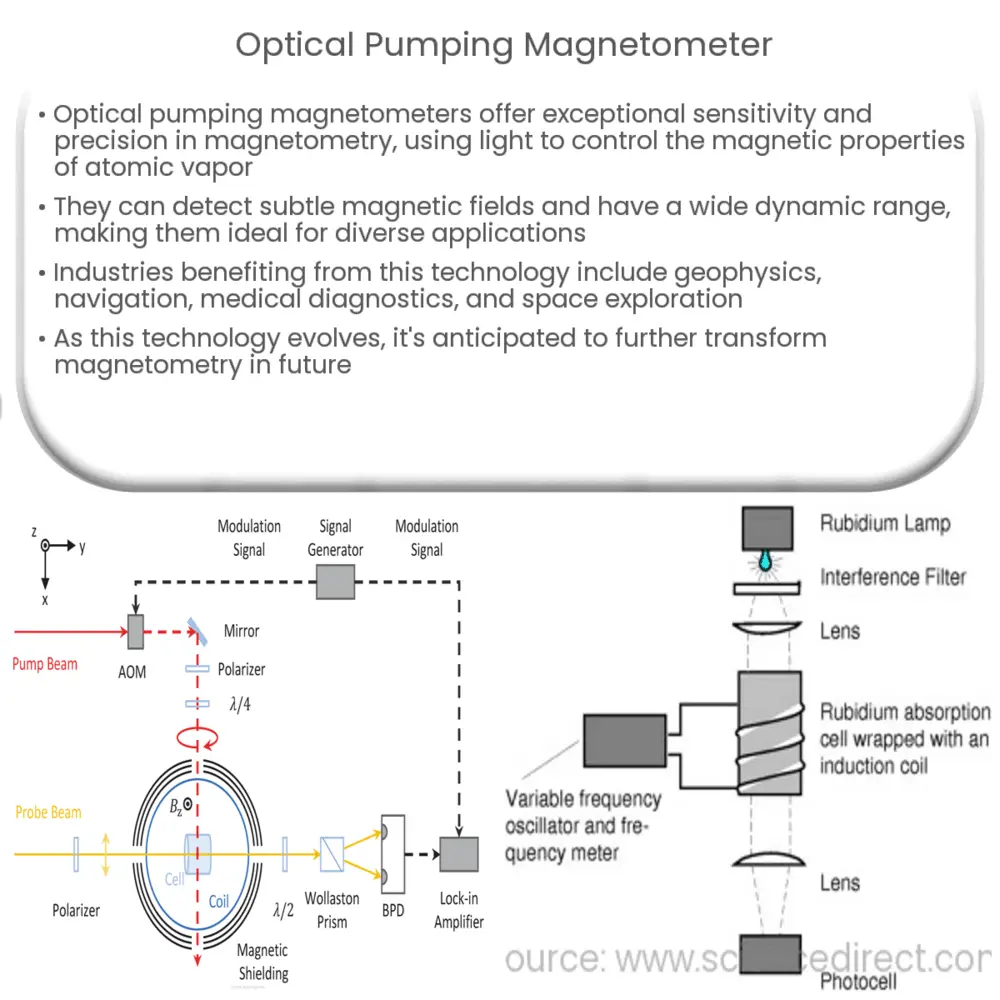Optical pumping magnetometers offer high sensitivity, wide dynamic range, and robust performance, enabling applications in geophysics, navigation, medical diagnostics, and space exploration.

Optical Pumping Magnetometer: A Revolutionary Sensing Technology
Introduction
Optical pumping magnetometers have emerged as a revolutionary sensing technology, offering exceptional sensitivity and precision in the field of magnetometry. These devices are based on the principle of optical pumping, a process that utilizes light to control the magnetic properties of atomic vapor. The optical pumping magnetometer’s unparalleled accuracy and robustness make it an ideal choice for a wide range of applications, including geophysics, navigation, and medical diagnostics. In this article, we will explore the working principle, advantages, and potential applications of this cutting-edge technology.
Working Principle of Optical Pumping Magnetometers
Optical pumping magnetometers rely on the interaction between light and atomic vapor to measure magnetic fields. The device typically consists of a glass cell filled with an alkali metal vapor (such as rubidium or cesium) and a light source, usually a laser. The laser is tuned to a specific frequency that corresponds to the energy level transition of the alkali metal atoms.
When the laser light interacts with the atomic vapor, it excites the atoms to a higher energy state through a process called optical pumping. As the atoms absorb and re-emit the laser photons, they become aligned with the direction of the magnetic field. The degree of atomic alignment, known as polarization, depends on the strength and orientation of the external magnetic field.
A secondary light source, typically an LED, is used to probe the polarization of the atoms. As the probe light passes through the vapor cell, its polarization is rotated due to the interaction with the polarized atoms. This rotation, known as the Faraday effect, is proportional to the strength of the magnetic field. By measuring the rotation of the probe light’s polarization, the magnetic field can be accurately determined.
Advantages of Optical Pumping Magnetometers
Optical pumping magnetometers offer several advantages over conventional magnetometers, such as fluxgate or proton precession devices. These advantages include:
- High sensitivity: Optical pumping magnetometers can detect extremely weak magnetic fields, with sensitivities in the femtotesla (fT) range. This allows for the detection of subtle magnetic anomalies that may be overlooked by other magnetometer types.
- Wide dynamic range: These magnetometers can measure magnetic fields over a broad range of magnitudes, from fT to several millitesla (mT). This versatility makes them suitable for a wide array of applications.
- Robustness: Optical pumping magnetometers are less susceptible to environmental factors, such as temperature fluctuations and mechanical vibrations, than other magnetometers. This robustness allows for more accurate and stable measurements in demanding environments.
- Fast response time: These devices can rapidly respond to changes in the magnetic field, making them ideal for real-time applications and dynamic measurements.
Potential Applications of Optical Pumping Magnetometers
Thanks to their exceptional performance characteristics, optical pumping magnetometers have found a variety of applications across multiple industries. Some of the most promising applications include:
- Geophysics: In the field of geophysics, optical pumping magnetometers are used to map the Earth’s magnetic field, detect magnetic anomalies, and explore for natural resources like minerals, oil, and gas. Their high sensitivity and wide dynamic range make them ideal for these applications, providing valuable insights into geological structures and processes.
- Navigation: The high accuracy and robustness of optical pumping magnetometers enable their use in navigation systems, particularly in environments where GPS signals may be weak or unavailable. They can be used to determine direction and orientation, as well as to detect changes in the Earth’s magnetic field that may affect navigational accuracy.
- Medical Diagnostics: Optical pumping magnetometers have shown promise in the detection of biomagnetic fields generated by human organs, such as the heart and brain. These fields are extremely weak, making them difficult to measure with conventional magnetometers. However, the high sensitivity of optical pumping magnetometers allows for the detection of these fields, potentially leading to new diagnostic tools and techniques in cardiology and neurology.
- Space Exploration: Optical pumping magnetometers can be used to measure magnetic fields in space, providing valuable data for understanding solar activity, planetary magnetic fields, and the interstellar medium. Their robustness and compact design make them well-suited for space missions, where reliability and minimal mass are crucial.
Conclusion
Optical pumping magnetometers have proven to be a powerful sensing technology, offering unprecedented sensitivity, a wide dynamic range, and robust performance in challenging environments. As a result, they have found numerous applications across various industries, including geophysics, navigation, medical diagnostics, and space exploration. As the technology continues to advance, it is expected that optical pumping magnetometers will play an increasingly important role in our understanding of the natural world and our ability to navigate and manipulate it. With their potential for unlocking new scientific discoveries and improving existing technologies, optical pumping magnetometers are poised to revolutionize the field of magnetometry in the coming years.

